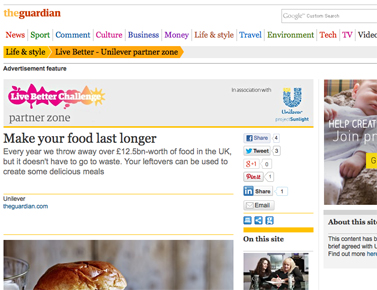Guardian Labs and the play for native advertising
 Banner advertising has long been the established method by which digital publishers generate income – but an increased use of mobile, difficultly innovating the humble skyscraper, and growing customer ‘blindness’ to banners has led many to re-evaluate their approach and instead start experimenting with native ads.
Banner advertising has long been the established method by which digital publishers generate income – but an increased use of mobile, difficultly innovating the humble skyscraper, and growing customer ‘blindness’ to banners has led many to re-evaluate their approach and instead start experimenting with native ads.
Guardian News & Media is the latest publisher to jump aboard the native ads bandwagon. The Guardian is by no means the only newspaper looking for new and innovative ways to raise revenue (in fact, the Times has been has been involved with branded content for years), but even by its own forward-thinking standards, its move into native advertising is a compelling one.
The publisher has set up a branded content division – called Guardian Labs – with the aim of creating innovative marketing campaigns that can stretch its revenue stream beyond display ads.
In effect, it has created an in-house agency to collaborate with advertisers on developing sponsored editorial content that is sufficiently compelling that it can be pushed in front of readers.
Anna Watkins, MD of Guardian Labs, outlined the way agency would help brands tell their stories:
It is the trinity of collaborative content, a progressive community and live data that enables us to connect so powerfully. By knowing our readers we can ensure that brands connect in a deeper, more meaningful way. As the most trusted newspaper in the UK we have a strong and valued relationship with our readers. This brings with it not only great opportunity, but also a strong sense of responsibility to safeguard that trust. To this end, we always clearly label our content for the benefit of all parties.
GNM is clearly keen to throw its weight behind the venture in the hope of big returns. The agency is launching with a team of creatives, designers, strategists and content producers that is 133-strong – that’s a whole host of new media jobs at a time when journalists are an increasingly rare breed.
These people will be expected to work closely alongside The Guardian’s editorial, digital development and marketing divisions.
In fact, the agency has already struck its first deal in excess of £1m by partnering with Unilever to bring elements of an existing marketing campaign that promotes sustainability – called Project Sunlight – to The Guardian as sponsored content.
Content created as part of the partnership sits within the Life & Style section of The Guardian’s website bracketed as the ‘partner zone’ element of a boarder Live Better Challenge section, which is also sponsored by Unilever and features related editorial from The Guardian.
The Guardian is known for its commercial independence and impartiality, so naturally any move to bring sponsored content alongside its ‘independent’ editorial is likely to raise concerns.
To avoid any muddying of its reputation, The Guardian appears to have taken clear steps to differentiate the two.
As Unilever sponsors the Live Better Challenge, all editorial that falls under that section appears with an ad saying ‘sponsored by Unilever’, but content created specifically for the ‘partner zone’ is clearly labelled as an ‘advertisement feature’, it also has a ‘Unilever’ byline, and at the end of each article this text appears:
This content has been paid for and produced to a brief agreed with Unilever, whose brand it displays. Find out more here.
To maintain the trust of readers The Guardian seems to have taken the necessary steps to differentiate sponsored content from its own related editorial, but perhaps other publishers might not prove to be so diligent. As native advertising develops, it’s clear that the media industry as a whole needs to set down some clear guidelines as to how these adverts are presented and labelled.
It remains to be seen whether or not they will take the Guardian Labs approach as a marker to follow.